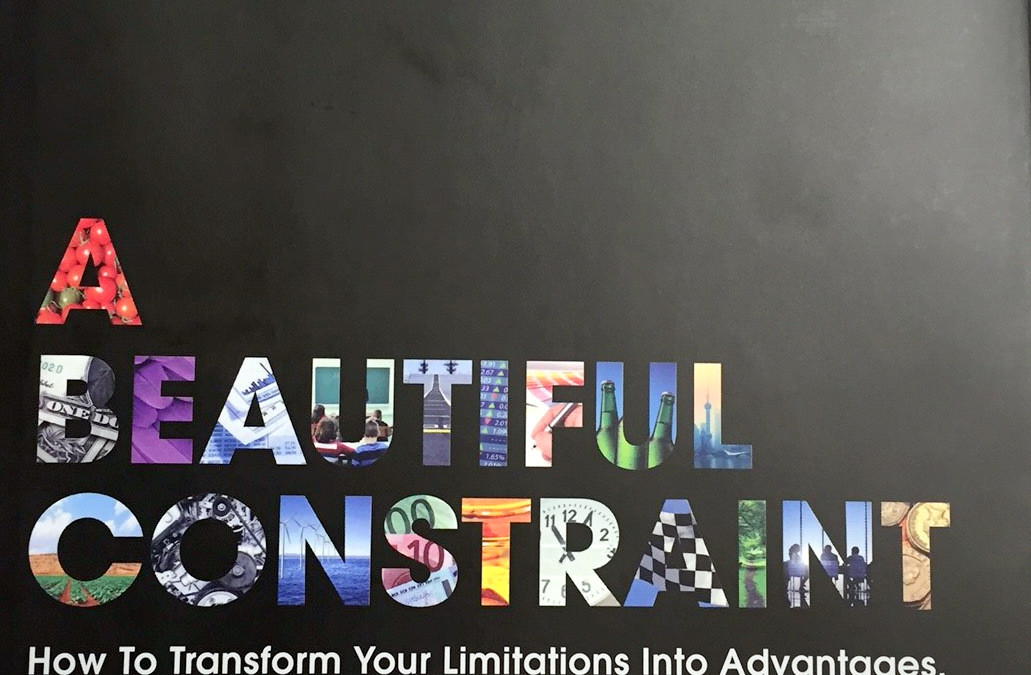I’m reading an excellent book called A Beautiful Constraint recommended to me by my friend Reka. Written by Adam Morgan and Mark Barden, this is a book for you if you feel the weight of constraints holding you back.
A Beautiful Constraint: How to Transform Your Limitations Into Advantages And Why It’s Everyone’s Business is a book how to overcome the impediments that constrain our actions every day.
We don’t have enough money, we can’t create or build our prototype fast enough, our competitors are too strong to allow for a new entry. Whether it is a lack of time, money or resources, something is always in the way of moving a project along.
The book explores constraints experienced by people through thirty-five personal interviews in companies and organizations as varied as The U.S.Navy, Nike, Formula One, Unilever, Brew Dog, public school teachers in California and even South African barley farmers. It offers practical ideas to reframe, rethink and shift how you solve problems.
I am devouring this book.
Can-If
The authors introduce the idea, what happens when you face a constraint as a positive statement versus a negative one. Instead of saying, the bank won’t fund our venture, what happens if you said, we CAN fund our investment IF ___________ happens.
Suddenly, you have redefined the problem by trying to figure out alternatives route to success from the original path.
In one example in the book, Taiwan was struggling with educational and economic issues. When they reframe questions through the CAN IF model, they see things anew:
- You could say, we can’t because we don’t have any natural resources. Or you could say, we CAN IF we think of people as natural resources.
- You could face a problem and say, we can’t succeed because our citizens only have a sixth-grade education. But you reframe the question by saying, we CAN IF we introduce an increase in primary education from six years to nine years.
- You can say, we can’t if we don’t have enough teachers. Or you could say, we CAN IF we find alternative teachers with students just graduating from university who don’t have formal teaching training.
- You can say, we don’t have time to train them, or you can ask, we CAN IF we find an alternative method that instructs them while they are working for us. (on the job training)
Path Dependent
The authors argue that we become path dependent assume that there is only one direction you can walk to solve a problem. The truth is – you see one way, but there are other ways to frame the situation.
During the 2008-2009 recession, people who wanted to start restaurants couldn’t get funding. But when they reframed the questions, they realized that they could get funding at lower levels if they considered a restaurant on wheels. Thus, the food truck revolution was born out of necessity and asking a different type of question. Could a restaurant be started that required less funding? The answer was yes – we can if we make it mobile.
Ask Propelling Questions
Are you asking propelling questions? These are the type that addresses a problem head on. A propelling question is both bold and intricately linked to your constraint. The folks at Google asked the question how you could reduce the 350,000 deaths on the highway each year due to human error. They framed the question, how can we prevent all road accidents created by human error? The constraint is at the root of his question and leads to their work in driverless cars.
A propelling question might reframe the issue too. The President of Audi desperately wanted to win the 24 hour LeMans race. Initially, he asked the question, how can we build a faster car. That was the path the company went down – until one of the engineers realized that the real question should be, how can we win at LeMans, since that was the objective. The answer came in eliminating several pit stops during the race so that they spend more time than the other cars on the track. The solution wasn’t to speed, it was finding a way to spend less time off the track getting fuel.
Every business I profile on my blog has taken a constraint and found a fresh and innovative solution. They market their brands, product or service by asking CAN IF questions and looking for an untraveled path forward. They challenge themselves with propelling issues that confront the limitations directly.
The pharmacists at Pill Pack asked a fresh question, how can they solve the problem their older customers face with too many pills and complexity in managing their medication.
The folks at Tovala wanted to make eating excellent home cook food easier but realized they couldn’t just give customers better food; they also needed to provide them with a better appliance to cook it in.
If you are stuck in a rut and need some fresh inspiration, pick up A Beautiful Constraint. And if you are broke and can’t spend the money, try the library. Or, ask me to lend you my copy.
Don’t let a little constraint get in your way.
__________
Need some help lifting, shifting and removing a few constraints. Email me at jeffreylynnslater@gmail.com or click here and let’s connect.
Photo: Cover of A Beautiful Constraint, all rights reserved by the authors and designers.




